|
Uluru, also known as Ayers Rock
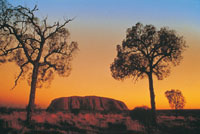 Welcome
to Aboriginal land Welcome
to Aboriginal land
Pukulngalya yanama, Ananguku Ngurakutu (welcome
greeting in Yankunytjatjara)
Pukulpa Pitjama, Ananguku Ngurakutu
(welcome greeting in Pitjantjatjara)
The traditional land owners of Uluru-Kata Tjuta National
Park, are direct descendants of the beings who created
our lands during the Tjukurpa (Creation Time). We have
always been here. We call ourselves Anangu, and would
like you to use that term for us.
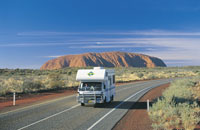 Uluru-Kata
Tjuta National Park is a world-class visitor destination
and a key part of Australia's iconic Red Centre. This
living cultural landscape is the physical and metaphoric
heart of Australia, and was one of the first areas to
be identified as a National Landscape. Uluru-Kata
Tjuta National Park is a world-class visitor destination
and a key part of Australia's iconic Red Centre. This
living cultural landscape is the physical and metaphoric
heart of Australia, and was one of the first areas to
be identified as a National Landscape.
Ayres rock Uluru, also referred to as Ayers Rock, is
a large sandstone rock formation in the southern part
of the Northern Territory, central Australia. It lies
335 km (208 mi) south west of the nearest large town,
Alice Springs; 450 km (280 mi) by road. Kata Tjuta (The
Olgas) and Uluru are the two major features of the Uluru
- Kata Tjuta National Park. Uluru is sacred to the Pitjantjatjara
and Yankunytjatjara, the Aboriginal people of the area.
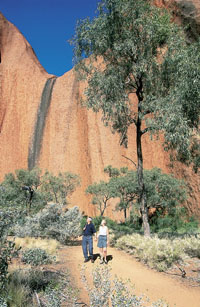 It
has many springs, waterholes, rock caves and ancient
paintings. Uluru is listed as a World Heritage Site.
The local Pitjantjatjara people call the landmark Uluru
. This word has no particular meaning in their dialect,
also known as Pitjantjatjara, but it is also used as
a local family name by the senior Traditional Owners
of Uluru. It
has many springs, waterholes, rock caves and ancient
paintings. Uluru is listed as a World Heritage Site.
The local Pitjantjatjara people call the landmark Uluru
. This word has no particular meaning in their dialect,
also known as Pitjantjatjara, but it is also used as
a local family name by the senior Traditional Owners
of Uluru.
On 19 July 1873, the surveyor William Gosse visited
Uluru and named it Ayers Rock in honour of the then-Chief
Secretary of South Australia, Sir Henry Ayers. Since
then, both names have been used, although Ayers Rock
was the most common name used by outsiders until recently.
In 1993, a dual naming policy was adopted that allowed
official names that consist of both the traditional
Aboriginal name and the English name.
On 15 December 1993, it was renamed "Ayers Rock/Uluru"
and became the first officially dual-named feature in
the Northern Territory. The order of the dual names
was officially reversed to "Uluru/Ayers Rock" on 6 November
2002 following a request from the Regional Tourism Association
in Alice Springs.
Uluru is one of Australia's most recognisable natural
icons. The world-renowned sandstone formation stands
348 m (1,142 ft) high (863 m/2,831 ft above sea level)
with most of its bulk below the ground, and measures
9.4 km (5.8 mi) in circumference.
Uluru is notable for appearing to change colour as
the different light strikes it at different times of
the day and year, with sunset a particularly remarkable
sight when it briefly glows red. Although rainfall is
uncommon in this semiarid area, during wet periods the
rock acquires a silvery-grey colour, with streaks of
black algae forming on the areas that serve as channels
for water flow. Uluru is an inselberg, literally "island
mountain", an isolated remnant left after the slow erosion
of an original mountain range. Uluru is also often referred
to as a monolith, although this is a somewhat ambiguous
term because of its multiple meanings, and thus a word
generally avoided by geologists.
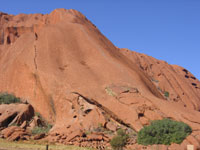 The
strata at Uluru are nearly vertical, dipping to the
south west at 85°, and have an exposed thickness of
at least 2,400 m (7,900 ft). The strata dip below the
surrounding plain and no doubt extend well beyond Uluru
in the subsurface, but the extent is not known. The
strata at Uluru are nearly vertical, dipping to the
south west at 85°, and have an exposed thickness of
at least 2,400 m (7,900 ft). The strata dip below the
surrounding plain and no doubt extend well beyond Uluru
in the subsurface, but the extent is not known.
Cultural Centre
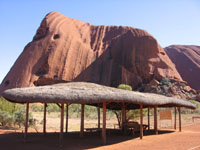 When
you visit Uluru - Kata Tjuta National Park, you should
ensure that you explore the Cultural Centre first. You
will enjoy exploring the Park much more if you understand
Anangu culture and this very special cultural and natural
environment. When
you visit Uluru - Kata Tjuta National Park, you should
ensure that you explore the Cultural Centre first. You
will enjoy exploring the Park much more if you understand
Anangu culture and this very special cultural and natural
environment.
At the Cultural Centre you can get an introduction
to Tjukurpa (law, knowledge, religion, philosophy),
Anangu art, Anangu way of life (traditional and current),
history, languages, wildlife and joint management of
the Park. The displays feature photo collages, oral
history sound panels, Pitjantjatjara language learning
interactives, soundscapes, videos and artefacts. There
are bush tucker sessions, plants walks and cultural
sessions for visitors to experience. Cultural Centre
notes are provided in Pitjantjatjara, English, Italian,
Japanese, German and French. A touch wall for visually
impaired people ensures that the messages are accessible
to everyone. Daily schedules vary, so ask at the Cultural
Centre Information Desk.
Park
Fees
|

